|
Find interviews by: | ||
Sherlock Holmes (Part 2) Go back to Part 1 of the review
Before you can say ‘prehistoric anachronism’, the T rex appears and chases the men through the trees. They eventually take shelter in a semi-derelict wooden building which apparently used to house the pump mechanism for the fountain - only it’s not there. The machinery has been stolen - which is why the fountain is only reaching half its normal height. I’m sure, like me, you’re wondering how the fountain is able to operate at any height if there’s no pump. You may also be wondering why a park fountain would require a separate building, some distance away, with a huge machine pump. There’s nothing like that near any of the fountains in any of my local parks... Around this time we are introduced to our chief villain, played by Dominic Keating from Star Trek: Enterprise, the only actor to fly over from LA although he’s actually British. In fact he was born in Beaumont Leys, just up the road from here. We know he’s the villain because we’ve seen the trailer but we don’t yet know who he is. He’s just a bloke in a wheelchair with a bad cough (and it’s not often you see a wheelchair with a cough - aythangyew!). This invalid is accompanied by an attractively formal woman who introduces herself as Anesidora Ivory (Elizabeth Arends, who was a cruise ship performer, appeared in an episode of Corrie and was in a stage play called Waitress for Godot!). Dressed like a Spanish widow who is secretly glad her husband fell off a boat, Anesidora holds herself upright at all times, neither smiles nor frowns and has pale skin which leads Watson to assume she is the patient, although she is actually seeking medication for the man in the wheelchair whom she calls her uncle. Dr Watson is somewhat smitten by the mysterious beauty and is all for asking her to the opera that very night until he receives a phone call from Holmes asking Watson to meet him in the East End that evening. A note on the telephones seen here seems in order, especially as the script goes to the trouble of having Holmes comment on what a marvel they are. And in fact they would have been in 1882, a mere six years after the introduction of telephony to the UK. Holmes appears to be using a proper Victorian phone, with a cylindrical doodad held to his ear, except that he is not actually talking into anything! At this early stage, the mouthpiece was part of the main phone device. Here is a photo of someone using an 1882 telephone. Notice how the speaker’s mouth is near the wall-mounted mouth-piece. Holmes just seems to be rabbiting into thin air. At the other end of the line, Watson is talking into a hulking great, 1940s-style bakelite device which is massively - and obviously - anachronistic. Now, here’s the thing. The commentary reveals that what Ben Syder is holding to his ear is actually a candlestick. I say bravo: terrific improvisation by props maker Keelie Shepard. But why stop there. All that was needed was a wooden box with a black-painted yoghurt pot stuck on the front and we would have believed that Holmes had a real Victorian phone with him. And then, since the two ends of the conversation are shot separately, why not reuse the same fake Victorian phone for Watson instead of giving him this thing that’s about 50-60 years too early?
The beast seems to rip Grolton’s head off - an exterior shot shows blood splatting against the inside of a window - but when Grolton’s body is thrown through the (supposedly heavily barred) window onto the cobbles below, his noggin is intact, albeit his skin is peeling and he is very much dead. Our intrepid duo force their way in and confront the beast, running around the factory (actually an industrial museum) until Holmes injures his leg. Back in Baker Street, there’s a lovely moment where Watson washes the wound with the nearest available alcohol and Holmes’ agony stems not from the pain but from the improper use of a particularly fine brandy. Finally, the investigation leads to a ‘castle’ (really a Tudor country house) where Holmes and Watson, after falling through a hole in the floor, find a static octopus and T rex - which, it must be said, is remarkably well-balanced as it stands silently. They also find what might at first be taken to be a steampunk automaton but actually turns out to be a powersuit. And this, without a doubt, is one the film’s strongest elements. Designed by Paul Curtis and constructed from leather painted to resemble brass, the suit is a magnificent creation - and wearable too! It has just enough gimcracks and gewgaws to really be a believable steampunk power-assisted exo-skeleton. The person inside knocks Holmes around a bit before being revealed as... Dominic Keating (we still don’t know his character’s name and indeed won’t until a potentially confusing epilogue to the movie). This makes sense, as we have previously seen him in a wheelchair. What we have here, not to put too fine a point on it, is a 19th century version of Iron Man. This film was released only a few months before Iron Man 2 so this is surely not coincidental, although nothing is made of it, even on the commentary. Instead, writer Bales says that the power-suit and its wearer were inspired by the legend of Spring-Heeled Jack. Which just leaves me scratching my head. Because there’s no connection or similarity at all. And that, my friends, is a huge disappointment. When I first heard about this movie and checked the cast list on the IMDB, seeing that Keating was credited as ‘Spring-Heeled Jack’ got me terribly excited (that’s not his on-screen credit).
Only one thing was unanimously agreed by all who saw Spring-Heeled Jack (and most who didn’t): he was a wrong’un. A lot of stories were published about Spring-Heeled Jack, some recounting ‘genuine’ sightings, others works of melodramatic fiction which enhanced and fed back into the urban legend. It’s difficult to separate fact from fiction when there are no actual substantial facts. On screen, Jack has only ever really appeared once, in Tod Slaughter’s 1946 Curse of the Wraydons, although the legend also inspired part of the 1924 German expressionist classic Waxworks. According to the IMDB, there was an American three-minute short about him in the late 1990s and I believe that Ashley Thorpe (Scayrecrow, The Screaming Skull) has a Spring-Heeled Jack short in development as part of his ‘Penny Dreadful’ series of digital animations. But a proper, big-budget (well, you know what I mean), feature-length, name-cast, steampunk tale pitting Spring-Heeled Jack against Britain’s greatest detective? That would be awesome! It would, you know. It would. And it’s the sort of thing The Asylum could do. I’d be happy to write it for them tomorrow. But this ain’t it. There is no suggestion that Dominic Keating (as we are forced to keep calling him) has used this power suit to terrorise the population or to wreak mischief among honest, God-fearing folk or even to leap over high walls. He can only just walk in the thing!
But before we get to that, something odd crops up in the dialogue: Holmes calls Keating ‘brother’. He actually addresses him directly as ‘brother’ several times. And Keating, in reply, calls Sherlock Holmes ‘Robert’. Eh? Leaving aside the ‘Robert’ schtick - as indeed the script does - our natural assumption is that Keating is playing Mycroft Holmes. After all, Sherlock only has one brother and we all know that Mycroft is cleverer than Holmes, although the industrious work of Keating’s character would be at odds with Mycroft’s languor. Mycroft has steampunk credentials, having been featured in The League of Extraordinary Gentlemen (the superb comic, not the shitty film). In fact, there is a Mycroft Holmes/Spring-Heeled Jack connection because of a 1997 comic called Predator: Nemesis in which Mycroft helped to bring said miscreant to justice, discovering in the process that the high-leaping demonic figure is actually one of those extraterrestrial hunters. But this character, according to the commentary, is not Mycroft. It’s some third Holmes brother never previously mentioned. Which is all well and good but we can’t tell that from the film. If Holmes would at least address his brother by name, we would twig that this is not Mycroft gone rogue, but he doesn’t. In fact, the constant use of ‘brother’ becomes tiresome and unrealistic. It’s the sort of thing that a sibling might do in a formal situation but to continue to use it when the brother in question is addressing you by your first name (or someone’s first name at least!) seems frankly rude. Again, the commentary provides an explanation. Keating’s character was originally written as Holmes’ uncle. Now, repeatedly addressing an older relative in a formal manner would sound credible. If we mentally replay this scene with the word ‘brother’ replaced with ‘uncle’, that’s slightly better. The casting of Keating in the role (he was 47 when he shot this) made the director rethink the relationship and turn him from uncle into brother. Which is fine for viewers who know nothing at all about Sherlock Holmes, but awfully confusing and misleading for those of us with a smidgeon of Holmes-ian knowledge. If there was at least a third-person reference to Mycroft, we would understand that this isn’t him. But no. Meanwhile, names and relationships notwithstanding, what is he up to? Well, for starters he has Inspector Lestrade imprisoned and trussed up. He also has an unhealthy relationship with Anesidora who not only isn’t his niece, she isn’t even human. She’s another robot, like the octopus and the dinosaur, which explains her stiff posture and her unwavering expression. Arends really does play the part very well, and the brief glance of smouldering passion between creator and automaton is a powerful and disturbing image that briefly lifts this otherwise bonkers third act into the realm of impressive science fiction drama. Oh, and she kills Sherlock Holmes. Shoots him dead. Right, that’s the end of him.
Let’s get this right. Keating constructed a giant, robotic octopus and used it to steal a shipload of tax money which he then spent on making a giant flying dragon, including the purchase of an enormous quantity of Grolton’s patent specialised rubber. He also built a half-size robotic dinosaur which he used to attack Grolton to prevent Holmes seeing an incriminating receipt for all that rubber. And he set the dinosaur loose against the whores of Whitechapel and their clientele and he even set it on his own brother, on whose unwitting behalf this grand vengeance was being orchestrated. Furthermore he built a power-suit and a life-size automaton realistic enough to fool a medical doctor and with which he has some weird, Coppelian relationship. Somewhere along the line he also stole a pump from a park fountain. Which seems odd because you would think that someone capable of manufacturing amazing machines like these would be able to build a simple bleeding pump. Now he is going to fly over London, inside his own robotic dragon, with the still bound-and-gagged Lestrade in the cockpit beside him for some reason, destroying iconic buildings and causing a general conflagration the likes of which hasn’t been seen since 1666. Which, for some reason, will be blamed by everyone on Lestrade. And on top of all this, he has placed a bomb inside Anesidora and despatched her to Buckingham Palace, there to threaten the life of Her Majesty Queen Victoria with a big explosion, presumably also as part of his scheme to frame Lestrade in revenge for the Inspector’s sidelining of Sherlock Holmes in documented accounts of cases on which they have worked together. Got it? It seems to me that the slight illogicality here - that an explosion at the gates of Buckingham Palace will actually have relatively little impact on a night when a dragon is setting fire to Westminster Abbey and St Paul’s Cathedral - is somewhat dwarfed by the elephant in the room, which is this: This whole plan is batshit insane! This redefines new levels of batshit insanity. You know those caves in South America that are home to colonies of millions of bats and are just coated inside with bat guano to a depth of several metres? Even that amount of batshit cannot convey how utterly and completely batshit insane this plan - and hence, let’s face it, the film’s essential plot - actually is. Don’t get me wrong: I love the dragon. A giant, flying, steampunk, robo-dragon attacking London is exactly what we want. It’s a sort of thematic cross between Reign of Fire and the climax of Doctor Who: ‘The Next Doctor’. For some reason the dragon actually looks robotic unlike the super-realistic giant octopus and Tyrannosaurus rex (and spooky-faced aspiring dominatrix).
As the dragon and the heli-balloon do battle above London, Anesidora strides calmly towards Buckingham Palace, although as she seems to be walking along an unlit, unpopulated country road it’s somewhat unclear from which direction she is approaching. She’s certainly not strolling up the Mall. The gates of the palace are guarded by four soldiers in uniforms which score points for authenticity but lose them again for lack of consistency. Two of the soldiers actually have speaking roles and challenge the approaching woman, albeit not with “Halt! Who goes there? Friend of foe?” which, as every schoolboy knows, is what British soldiers are required to shout when on guard and approached by an unknown person. Perhaps these particular palace guards were confused by some prior disagreement over which regiment was actually supposed to be guarding Buckingham Palace that night, since the officer (who, for some reason, has no chin-strap on his bearskin) is wearing the uniform of the Coldstream Guards while the private alongside him is very obviously in the uniform of the Grenadier Guards. No, I’m being unfair when I say ‘obviously’. This is not something that most people, even most British people, will notice. And I suspect that whichever Welsh theatrical costumier supplied the uniforms probably didn’t have a particularly extensive range of Royal Guardsmen tunics. We’ll let this one go. I don’t think it’s a spoiler to say that Watson stops Anesidora. There’s actually quite a nice character arc there. Watson is initially attracted to the mysterious femme fatale when she visits his surgery, then saddened to find that her ‘uncle’s’ relationship with her is distinctly unavuncular, then horrified to learn that she is an unthinking automaton capable of the motions of love but not the emotions, and finally forced to destroy her in his duty as an upstanding Englishman. Meanwhile, in a ludicrously ambitious sky battle which is nevertheless thrilling, exciting and enjoyable, Holmes eventually defeats his brother, parachuting to safety as the heli-balloon crashes, while the impact of the dragon on the ground fatally injures Keating but apparently leaves Lestrade relatively unscathed, even though logic tells us that only the former would have been able to actually hold onto something as the reptilian steampunk aircraft plummeted to Earth.
Next we leap forward to December 1940 where geriatric Watson finishes recounting his tale to Lucy Hudson and then expires peacefully. And if Miss Hudson had any sense, she would take that as her cue to grab her gas-mask and head down to the nearest shelter. Finally, we jump forward a short time to a brief churchyard scene. As Miss Hudson visit the grave of Dr John Watson, another figure passes by in the background. A stiffly formal, vaguely Spanish-looking woman. It is Anesidora (or at least, an Anesidora), unchanged since we last saw her some six decades ago. And she is placing flowers on the unintentionally cheap-looking grave of ‘T Holmes’. Which is our first clue, moments before the credits roll, that Keating’s character was not Mycroft. And moments later the credits do indeed confirm that he played ‘Thorpe Holmes.’ Which also explains why, in the eight-and-a-half-minute Making Of, Keating introduces himself with, “I’m Dominic Keating and I play Thorpe.” And what a Making Of! In less than nine minutes we get comments from (or at least have identified for us) all five main cast members, line producer Steve Fiske, 1st assistant camera Bryan Olinger (subsequently promoted to DP on Mega Piranha), robo-suit designer Paul Curtis, director Rachel Goldenberg, ‘creative consultant’ Roy Gerard Calder, costume designer Nikkie Alsford (Dogging: A Love Story), passing journalist Brian Raftery, production assistant Dilwyn Parry Jones, bit-part actors Dennis Jones and Dylan Jones, sound recordist Ben Forman (Silent Night Zombie Night, Haunting of Winchester House), Steadicam op Luke Rocheleau (Juko’s Time Machine), make-up artist Ruth Pease (Psychosis) and 1st AD Alexander X Hutchinson (temporarily promoted from his regular Asylum gig as 2nd AD) who gets more on-screen comments than anyone - possibly because he was one of three people who shot this Making Of - and just never stops complaining. He doesn’t like the film, he doesn’t like the schedule, he doesn’t like Wales. Miserable bleeder. Sherlock Holmes was shot on a tight 13-day schedule in and around Caernarfon in September 2009. HMS Pickle, a charity-owned replica of a schooner which served under Nelson at Trafalgar, is the ship that gets attacked by the octopus. Dinorwig Quarry Hospital (miscredited as ‘Dinowig’) was used for Watson’s surgery and the adjacent National Slate Museum provided a great location for Grolton’s rubber factory. Thorpe’s lair was Gwydir Castle while Glynliffon Mansion and the Faenol Estate also provided scenery. Basically, as an advert for Gwynedd tourism, Sherlock Holmes scores admirably. The area looks lovely and full of fascinating industrial heritage. A trip to Anglesey was required for the cliff top scenes filmed on South Stack cliffs.
Three directors of photography are credited: Bryan Olinger (despite his Making Of credit as 1st AC), Scott Wheeler (of effects house Tiny Juggernaut, who are The Asylum’s regular VFX providers) and Paul Saunders (previously 1st AC on The Terminators and Transmorphers 2). With the ever-cheerful Alexander X Hutchinson as 1st assistant director, the vacant 2nd AD role was taken by Shelley Tyson, fresh from You-Know-Who’s musical-horror-western Eldorado. Much of the logistical credit for Sherlock Holmes must go to Helen Pritchard, credited as ‘UK production manager’ who supplied supporting cast and background extras through her Clic Agency and also helped with locations etc. She was also a key figure in The Asylum’s previous Welsh-shot feature, Merlin and the War of Dragons. Of the three leads, two are well-known. Outside of the Hub, Gareth David-Lloyd has done TV work in stuff like Rosemary and Thyme and Casualty and has been attached to a mooted British sci-fi feature, Casimir Effect. Away from the Enterprise, Dominic Keating has had recurring roles in Heroes and The Immortal, appeared in Species IV and Beowulf, and way back when he was in stuff like Inspector Morse and, indeed, Casualty. But Ben Syder is a genuine discovery. Born in Prestatyn, he has been acting since 2006, has done some stage work and some student shorts but this is his feature debut. It takes a while to get used to his mannerisms but once he (or it might be me) settled down, he came across very well indeed. Catriona McDonald, who appears briefly as Mrs Hudson, was in another intriguing Victorian fantasy, Newgate, about which I have never been able to discover very much. A few of the other speaking cast were also in Merlin and the War of Dragons. ‘Additional FX’ are credited to Latitude Effects (aka Erica Steele and Mark Atkins of Ghost Show Pictures). Writer Paul Bales is one of the partners in The Asylum, where he “handles the day-to-day operations of the company, administration and finance, and domestic sales.” His other scripts for the company include Legion of the Dead (which he also directed), The Da Vinci Treasure, 100 Million BC and Megafault. Director Rachel Lee Goldenberg wrote and directed one of The Asylum’s more atypical features, Sunday School Musical(!) and was 1st AD on the likes of I am Omega, Alien vs Hunter, Monster, 2012: Supernova, The Seven Adventures of Sinbad and Princess of Mars.
The effects are, on the whole, great. I mean, they’re not Industrial Light and Magic. But dollar for dollar they’re pretty damn good and certainly good enough for a film of this ilk. Some big Hollywood piece of crap could do the same and it would be ten, maybe a hundred times better - but that would cost a thousand, maybe ten thousand times more. And take a couple of years. And employ so many people that the producers would need the rights to a whole other song for the additional three minutes of credits while endless lists of computer programmers’ names scrolled past an empty auditorium. Goldenberg’s direction is all right. I guess, given the ultra-tight schedule and other logistical restraints like shooting in (effectively) the middle of nowhere. There are small moments when the direction shines, but there are bigger aspects where it falls down and Goldenberg must take responsibility for the changes to Paul Bales’ script and how they affect the finished movie. For example, replacing the submarine sequence with the cliff sequence is reasonable and there are some nice character touches in that scene - but it makes no sense in terms of investigating a ship that sank out of sight of land. The body in the water element of the scene appears from nowhere and goes nowhere and the whole sequence, as previously mentioned, comes to nought. Similarly, Goldenberg’s decision to make Keating’s character a brother seems to have consisted of simply crossing out ‘uncle’ in the script and writing ‘brother’ in with a biro. No thought has been given to either how that affects the dialogue - brothers would address each other by first name - or what ramifications it might have in terms of conflicting with the cultural baggage of Sherlock Holmes. Just one additional line of dialogue that alluded to Mycroft and established that this isn’t him would have sufficed. Paul Bales can’t be blamed for this; he was in LA while all this was going on. And that scene of a paperboy throwing a rolled-up newspaper onto the doorstep of 221 Baker Street still rankles with me. Because it is so wrong in so many ways, not one of which would have required additional expense or time. Just care. Having said all that, what Paul Bales can be held responsible for is the completely arbitrary and nonsensical plot. Sherlock Holmes stories are lot harder to write than you might think because they have to be incredibly clever. It’s not enough to slip in little references to the canon if the actual plot doesn’t hang together in a way that befits the character. I’m entirely undecided on whether extending the world of Holmes into a steampunk fantasy milieu makes plotting easier or more difficult, possibly both. But I do know that the script’s attempts to justify and explain Thorpe’s actions don’t hold up at all, either in terms of making sense or as a solution to the preceding mystery elements. Embracing the fantastique does not negate the requirements of cause and effect. I wouldn’t want to deny us all the pleasure of a dinosaur, a giant octopus, a brass power-suit, a robot woman and a heli-balloon vs robo-dragon battle above the Thames - but perhaps it might have been better to simply make Thorpe an eccentric madman rather than try to justify his surreally unjustifiable actions.
As well as the commentary track and Making Of, which I was glad to see Revolver kept for the UK disc, the extras include a trailer and a couple of minutes of bloopers which includes, for once, something genuinely funny. It’s an overhead shot of Holmes in the heli-balloon basket (not actually used in the film) which has to cut when a piece of the camera actually falls off and lands on the hapless Syder’s head. Has to be seen to be believed. Finally, it’s worth noting that the UK sleeve differs significantly from the US version. Both have the Palace of Westminster in flames and a giant octopus attacking Westminster Bridge, but for the UK a two-shot of Syder and David-Lloyd has replaced the three-shot of those two fellows plus Keating. More to the point, the dragon and the T rex both appear twice. Bit since the octopus doesn’t attack Westminster Bridge, the image is already an exaggeration so what the heck, chuck a few more reptilian robots in there. And even more to the point, the dark background to the original one-sheet has been abandoned in favour of a sort of blue-grey sheen which makes this look just that little but more like the Guy Ritchie film. (Which I haven’t seen and I’m not really bothered about, whereas I pre-ordered this from Amazon the moment I found out it was getting a UK release.) MJS rating: B+ Go back to Part 1 of the review | ||

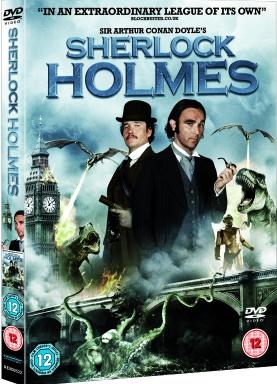 After breakfast, Watson and Holmes go for a ‘morning constitutional’. A cynic might think their chosen area is rather thickly wooded for central London but in fact London is a green city and there are plenty of densely forested parks within easy walking distance of Baker Street, so I’ll happy approve this decision. They observe that a park fountain is rather lacklustre this morning, compared with its usual height, just as a drunk bloke (Dennis Jones, recognisable as an extra in other scenes) runs past them, screaming about a monster.
After breakfast, Watson and Holmes go for a ‘morning constitutional’. A cynic might think their chosen area is rather thickly wooded for central London but in fact London is a green city and there are plenty of densely forested parks within easy walking distance of Baker Street, so I’ll happy approve this decision. They observe that a park fountain is rather lacklustre this morning, compared with its usual height, just as a drunk bloke (Dennis Jones, recognisable as an extra in other scenes) runs past them, screaming about a monster.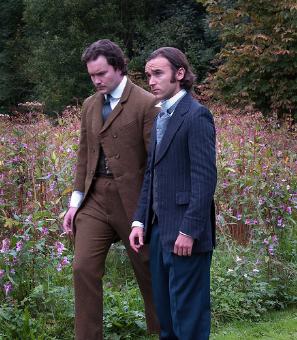 Holmes and Watson’s investigations take them to a rubber factory run by (and apparently entirely staffed by) a suspicious character named Grolton (Dylan Jones, who also supervised the horses used on the shoot). Grolton says he sold a large order of rubber to an anonymous purchaser whom he never saw but when he grudgingly goes inside the building to find the invoice (following Holmes’ suggestion that the rozzers might be interested in certain matters of employment law in his factory...) what should turn up but that pesky T rex.
Holmes and Watson’s investigations take them to a rubber factory run by (and apparently entirely staffed by) a suspicious character named Grolton (Dylan Jones, who also supervised the horses used on the shoot). Grolton says he sold a large order of rubber to an anonymous purchaser whom he never saw but when he grudgingly goes inside the building to find the invoice (following Holmes’ suggestion that the rozzers might be interested in certain matters of employment law in his factory...) what should turn up but that pesky T rex.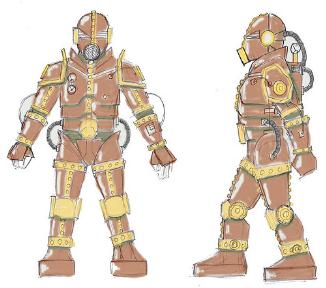 Spring-Heeled Jack is a Victorian urban myth of tremendous potential. From the 1830s through to the turn of the century, stories surfaced sporadically across England of a mysterious figure who could make extravagant, superhuman leaps over walls and onto rooftops. In some reports he was a man, in some he was dressed as a devil, and some witnesses claimed he was the Devil himself (or one of his demonic minions). There were reports that his eyes glowed red, many anecdotes had him breathing fire, everyone agreed he wore a long, dark cloak. Some people reported being physically attacked, others were shocked or terrified, still others considered Jack a naughty trickster.
Spring-Heeled Jack is a Victorian urban myth of tremendous potential. From the 1830s through to the turn of the century, stories surfaced sporadically across England of a mysterious figure who could make extravagant, superhuman leaps over walls and onto rooftops. In some reports he was a man, in some he was dressed as a devil, and some witnesses claimed he was the Devil himself (or one of his demonic minions). There were reports that his eyes glowed red, many anecdotes had him breathing fire, everyone agreed he wore a long, dark cloak. Some people reported being physically attacked, others were shocked or terrified, still others considered Jack a naughty trickster.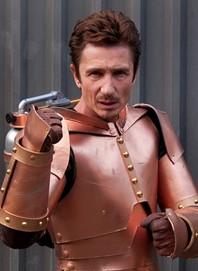 So what is he up to? Gradually we now discover his nefarious plans and I must say that they are, without a doubt, the most random, unfocused, nonsensical criminal plans I have ever heard explained from the speakers of my TV set.
So what is he up to? Gradually we now discover his nefarious plans and I must say that they are, without a doubt, the most random, unfocused, nonsensical criminal plans I have ever heard explained from the speakers of my TV set.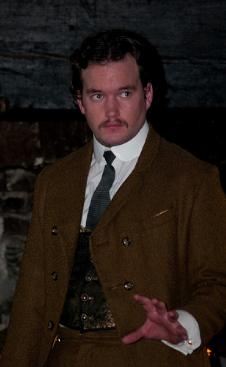 Poor old Watson gets strapped to some sort of torture apparatus as Keating explains the details of his plan, all of which is motivated by a sense of revenge against Lestrade. It seems that Keating is an ex-copper who worked alongside Lestrade but retired through injury. Since then he has noticed how Lestrade has been in the habit of taking the credit for cases solved by Keating’s estranged brother ‘Robert’. And so aggrieved by this is the elder sibling that he plans to attack London with a giant, flying, fire-breathing robotic dragon - and then blame that on Lestrade!
Poor old Watson gets strapped to some sort of torture apparatus as Keating explains the details of his plan, all of which is motivated by a sense of revenge against Lestrade. It seems that Keating is an ex-copper who worked alongside Lestrade but retired through injury. Since then he has noticed how Lestrade has been in the habit of taking the credit for cases solved by Keating’s estranged brother ‘Robert’. And so aggrieved by this is the elder sibling that he plans to attack London with a giant, flying, fire-breathing robotic dragon - and then blame that on Lestrade!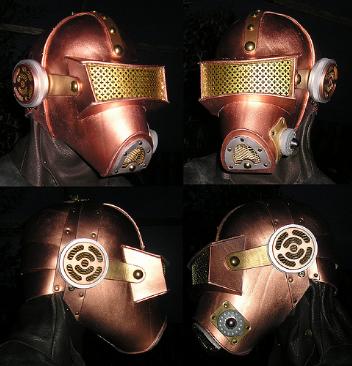 I also love the crazy hybrid between a hot-air balloon and a helicopter with which Sherlock Holmes gives chase after he has emerged miraculously (if not unexpectedly) alive and freed the surprised Watson. While Holmes flies up and away in the ‘airship’ which his brother somehow also found the time to build, Watson sets off for central London on horseback. Which is optimistic because Anesidora has not only got a good head-start, she’s travelling by train. Granted it is, apparently, a little branch line, but it’s still trundling along at a good speed and not going to need to stop for some hay.
I also love the crazy hybrid between a hot-air balloon and a helicopter with which Sherlock Holmes gives chase after he has emerged miraculously (if not unexpectedly) alive and freed the surprised Watson. While Holmes flies up and away in the ‘airship’ which his brother somehow also found the time to build, Watson sets off for central London on horseback. Which is optimistic because Anesidora has not only got a good head-start, she’s travelling by train. Granted it is, apparently, a little branch line, but it’s still trundling along at a good speed and not going to need to stop for some hay.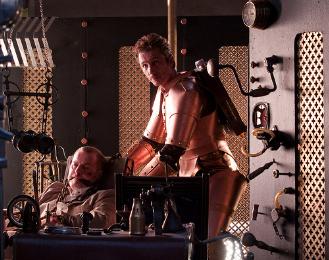 In the first of three epilogues, Holmes mentions to Watson, over breakfast back in Baker Street, that his first name is actually Robert. What? No it isn’t - it’s Sherlock. Many were the Victorian gentlemen who were known by two names that were actually a double-barrelled, unhyphenated surname: Conan Doyle for one. But England’s greatest detective isn’t called Something Sherlock Holmes. He’s called Something Holmes. Or are we to think that he is one of those people who choose to use their second Christian name instead of their first? Is ‘Sherlock’ a middle name or the first half of a double-barrelled surname? Frankly, who cares? This revelation seems utterly pointless and doesn’t enhance the film one iota. It could be the least exciting revelation of any movie epilogue ever.
In the first of three epilogues, Holmes mentions to Watson, over breakfast back in Baker Street, that his first name is actually Robert. What? No it isn’t - it’s Sherlock. Many were the Victorian gentlemen who were known by two names that were actually a double-barrelled, unhyphenated surname: Conan Doyle for one. But England’s greatest detective isn’t called Something Sherlock Holmes. He’s called Something Holmes. Or are we to think that he is one of those people who choose to use their second Christian name instead of their first? Is ‘Sherlock’ a middle name or the first half of a double-barrelled surname? Frankly, who cares? This revelation seems utterly pointless and doesn’t enhance the film one iota. It could be the least exciting revelation of any movie epilogue ever. Mere hours after wrapping, most of the Transatlantic travellers caught a plane back, leaving the director and cameraman to spend a couple of days in London getting establishing shots and effects plates by pretending to be tourists videoing their holiday. A final day of ‘second unit’ photography in Malibu, including the ultimately pointless body-in-the-sea shots, was line produced by
Mere hours after wrapping, most of the Transatlantic travellers caught a plane back, leaving the director and cameraman to spend a couple of days in London getting establishing shots and effects plates by pretending to be tourists videoing their holiday. A final day of ‘second unit’ photography in Malibu, including the ultimately pointless body-in-the-sea shots, was line produced by 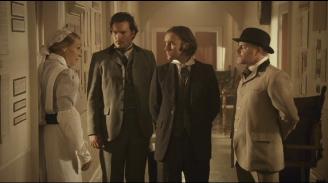 So what works and what doesn’t on The Asylum’s
So what works and what doesn’t on The Asylum’s 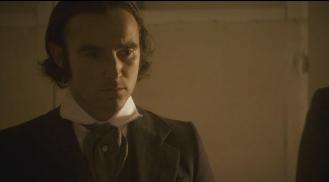 But let’s be clear about one thing. Despite its faults, I absolutely loved this movie. Having watched it, I was quite happy to watch it again a few days later for the commentary - and there are not many films to which I will extend that courtesy. This is a rip-roaring, action-packed, science-fantasy adventure: hugely enjoyable and daft as a brush. And kudos to The Asylum for filming it in Britain. God knows that Holmes has been badly served over the years by some bloody awful films, many of which shuffled him to America and/or the 20th century to save on collar-studs and gas-lamps. This film shows that even on a tiny budget, some degree of historical verisimilitude can be managed.
But let’s be clear about one thing. Despite its faults, I absolutely loved this movie. Having watched it, I was quite happy to watch it again a few days later for the commentary - and there are not many films to which I will extend that courtesy. This is a rip-roaring, action-packed, science-fantasy adventure: hugely enjoyable and daft as a brush. And kudos to The Asylum for filming it in Britain. God knows that Holmes has been badly served over the years by some bloody awful films, many of which shuffled him to America and/or the 20th century to save on collar-studs and gas-lamps. This film shows that even on a tiny budget, some degree of historical verisimilitude can be managed.